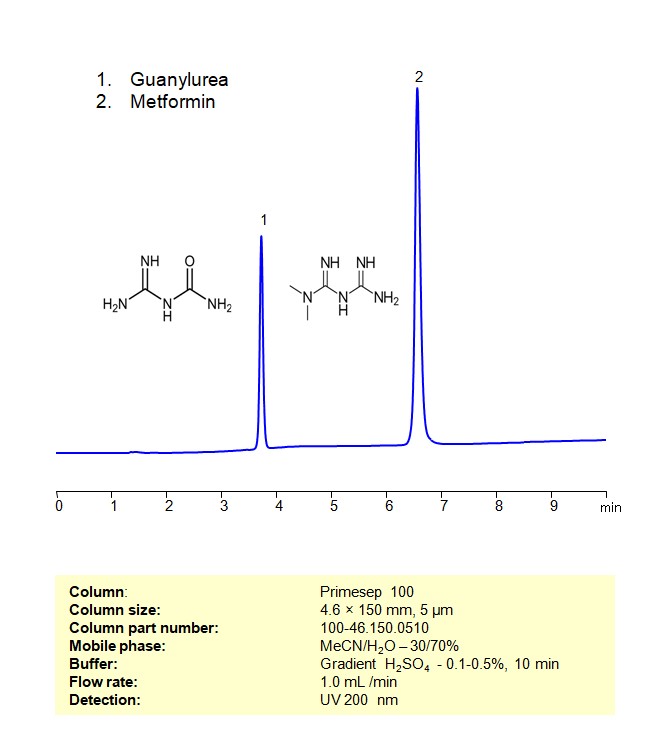HPLC Method for Analysis of Guanylurea, Metformin on Primesep 100 by SIELC Technologies

High Performance Liquid Chromatography (HPLC) Method for Analysis of Guanylurea, Metformin
Guanylurea is a known degradation product of metformin. When metformin undergoes biotransformation in the body, one of the metabolic pathways leads to the formation of guanylurea. This process is a part of the pharmacokinetics of metformin, where the drug is metabolized and eventually excreted from the body.
The conversion of metformin to guanylurea is significant for a few reasons:
Pharmacokinetics: Understanding the metabolism of metformin, including its conversion to guanylurea, is important for comprehending its action in the body, its elimination, and any potential metabolite-related effects.
Environmental Impact: The presence of pharmaceuticals and their metabolites, like guanylurea from metformin, in the environment (especially in water sources) has become a topic of environmental concern. This is because these compounds can have effects on aquatic life and potentially re-enter the human water supply.
Safety and Efficacy: Knowing the metabolites of a drug helps in assessing its safety and efficacy. While guanylurea is not known to have significant pharmacological effects in the context of metformin’s use as a diabetes medication, its identification is essential for a complete understanding of the drug’s profile.
Guanylurea: This is the main known metabolite of metformin. It is formed through the breakdown of metformin in the liver. Despite being the primary metabolite, guanylurea is considered to have minimal pharmacological activity, especially in the context of the glucose-lowering effects of metformin.
Guanylurea and Metformin can be retained, separated and analyzed on a Primesep 100 mixed-mode stationary phase column using an analytical method with a simple mobile phase of water, Acetonitrile (MeCN), and a sulfuric acid as a buffer. This analysis method can be detected using UV at 200 nm.
| Column | Primesep 100, 4.6 x 150 mm, 5 µm, 100 A, dual ended |
| Mobile Phase | MeCN/H2O – 30/70% |
| Buffer | Gradient H2SO4 -0.1-0.5%, 10 min |
| Flow Rate | 1.0 ml/min |
| Detection | UV 200 nm |
| Sample | Guanylurea phosphate 0.2 mg/ml in H2O and 1,1-Dimethylbiguanide hydrochloride 0.2 mg/ml in H2O |
| Class of Compounds | Ureas |
| Analyzing Compounds | Guanylurea, Metformin |
Application Column
Primesep 100
Column Diameter: 4.6 mm
Column Length: 150 mm
Particle Size: 5 µm
Pore Size: 100 A
Column options: dual ended
Metformin





